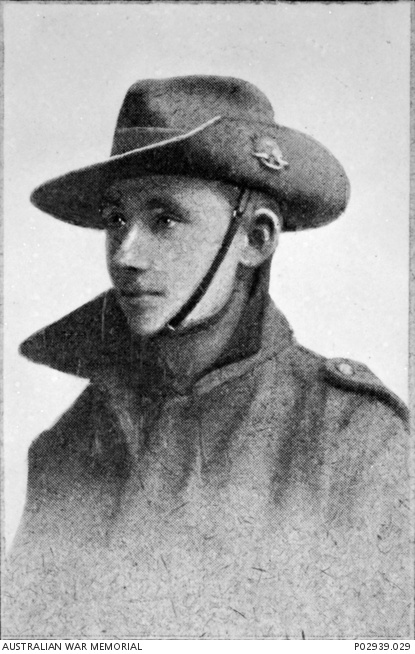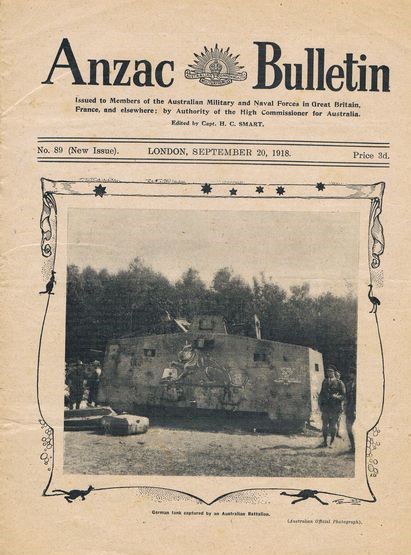Stunt at Villers-Bretonneux
Katanning born Sergeant John Augustine (Gus) Keley enlisted from Busselton on 9 February, 1915, aged 18 years. His unit, the 11th Battalion, 5th Reinforcement embarked from Fremantle, Western Australia, on board HMAT A20 Hororata on 26 April 1915. He also served with the 13th and 51st Brigades and an American force prior to his return to Western Australia on 28 February 1919.
The Stunt at Villers-Bretonneux
Southern Districts Advocate
20 January, 1919 (p4)
Sergeant Gus Keeley, writing to his brother Joe, of Katanning, gives an interesting account of the above stunt. He says: –
“We left Corbie on the 23rd April and proceeded to a place called Port Moyelle for a rest on the 24th. While on parade word arrived that the ‘Huns had attacked and had made a breach in the line at Villers-Bretonneux. So we had to pack up and march; a distance of about 15 kilometres, half the way in artillery formation, and you know how trying that is.
“On the way up, we were informed that we were to attack without artillery or tank. support, in conjunction with the 15 Brigade A. I. F. and English troops, at 10 p.m. Time was very short, so we had to make a forced march and arrived on the jumping off tape ten minutes late. But we started the attack immediately and caught the other troops on the first wire.
Before going any further, I will explain the idea of the stunt. The 15th Australian Brigade was attacking on the left of Villers-Bretonneux, and the 13th Australian Brigade (ours) and the British troops on the right, the idea being to work round the village and connect up the other side, surrounding the garrison. The 13th Brigade had a very nasty sector, having to cross two belts of wire, with their left flank open resting on a wood held by machine guns. The 51st Bat. (W.A.’s) were on the left, and the 52nd (mixed) on the right, with the 50th Bat. (S.A.’s) in support, and 49 (Queenslanders) in reserve.

C. W. K. Sadlier VC
“From the start the 51st had to fight hard, and lost very heavily in officers and men, through machine gun fire from the left flank. It was here that Lieut. C. W. K. Sadlier, seeing the desperate situation we were in, worked round to the flank with a small party, and attacked the machine guns. When all his party had become casualties, he carried on by himself and captured the guns, receiving a wound.
The clearing of these guns saved what remained of our battalion and enabled us to carry on the attack. Lieutenant Sadlier was awarded the V.C. for this fine piece of work. After passing this obstacle, heavy resistance was encountered on both belts of wire, but was overcome by bombs and rifles.
“Dawn found us on a small ridge about 300 yds short of our objective, and it was decided to dig in where we were on account of the heavy casualties.
“The 15th Brigade gained their objective about half-an-hour later, and Villers-Bretonneux was surrounded, except for the gap between the 15th and 13th Brigades. The Germans were unable to escape through this gap as it was commanded by our Lewis gun fire, and at lunch time the garrison surrendered. This ended one of the hardest fights we have ever experienced.
“Amongst the officers who fell here were Capt. C. E. A. Cooke, from Kalgoorlie, killed; Capt. F. Smith, from the same place, killed; Lieut. J. Barrett, from Capel, killed; J. J. Kitchen, from Perth, killed; Lieut. Charlton, wounded.
The Sergeants were George Smith, Monty Davies and Geo. Nash killed, and Sergeant Mackay wounded. All these were A Co., with the exception of Captain Smith. I cannot remember the officers and sergeants from the other Companies, but they were almost as heavy.
In A Coy. no officer, and only two sergeants and a lance-corporal, got through unhurt, out of four officers, seven sergeants and 15 lance corporals.
“At present we are at a place called Fresnoy, en route for one of the. Rhine towns, and as far as we know will garrison Coblenz. But I am not keen on the idea – Aussie will always do me,

Enclosed in the letter was a copy of the “Anzac Bulletin,” containing the remarks of Lieut-General Sir John Monash at a luncheon given in his honor at, the Australian and New Zealand Club in London, from which we take the following extracts:
“The story of the part played by the Australians in the past six months was a very fine one. When they were opposite Amiens, about seven miles east of it, they met the German army, which had the impetus of five days successes behind it. Three Australian divisions stopped that army, and when the whole Allied line was waiting to see where the next blow would come, the Australians carried every week a small offensive which was every time successful.
It was this that prevented the enemy from making his attack, which was intended to culminate in cutting a gap between the British and French armies. That, appropriately enough, was on the anniversary of ANZAC Day.
Then came Villers-Bretonneux, which the Australians captured with a thousand prisoners. This was the star crisis of the war. It gave time for the Allies to perfect their defences, and. for the Americans to arrive in strength.”
Also, the Bulletin contains a despatch from Sir Douglas Haig, in which it is noted, regarding the Villers-Bretonneux engagement:
“The 13th Australian Brigade, in particular, showed great skill and resolution in their attack, making their way through belts of wire running diagonally to the line of their advance, across very difficult country, which they had had no opportunity to reconnoitre beforehand.”
In will be noticed that throughout his letter Sergeant Keeley makes no mention of anything done by himself, yet it was during that engagement his bravery earned for him the Military Medal. After having been injured he continued to advance and use his Lewis gun with such deadly effect as to check strong opposition and make it possible for the infantry to gain their objective. Sergeant Keeley was afterwards detailed to an American force for some time as an instructor, and from there was granted furlough to England.
Sergeant Keeley also earned an American Distinguished Service Medal (ed).

.
Stunt at Villers-Bretonneux. Stunt at Villers-Bretonneux. Stunt at Villers-Bretonneux. Stunt at Villers-Bretonneux.
